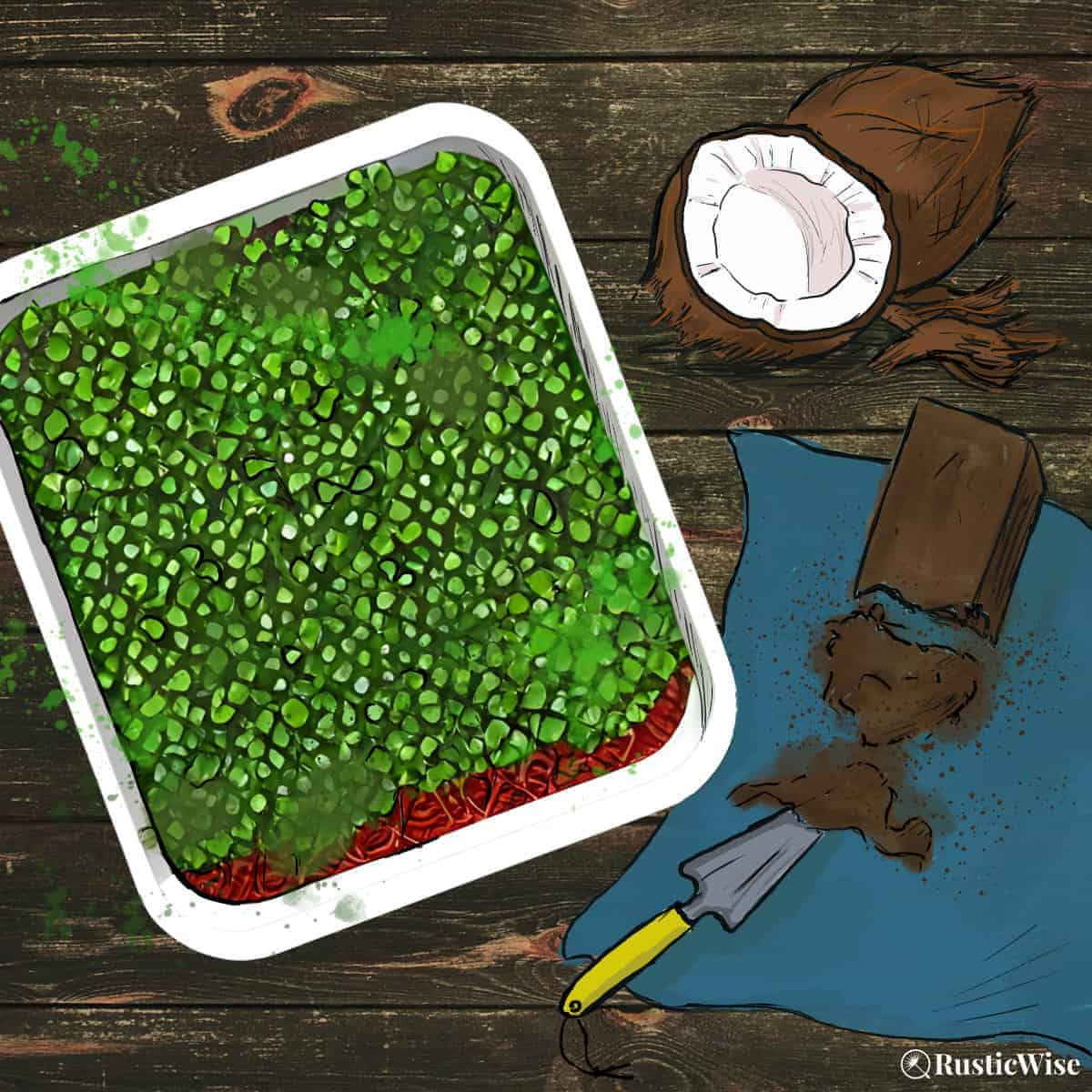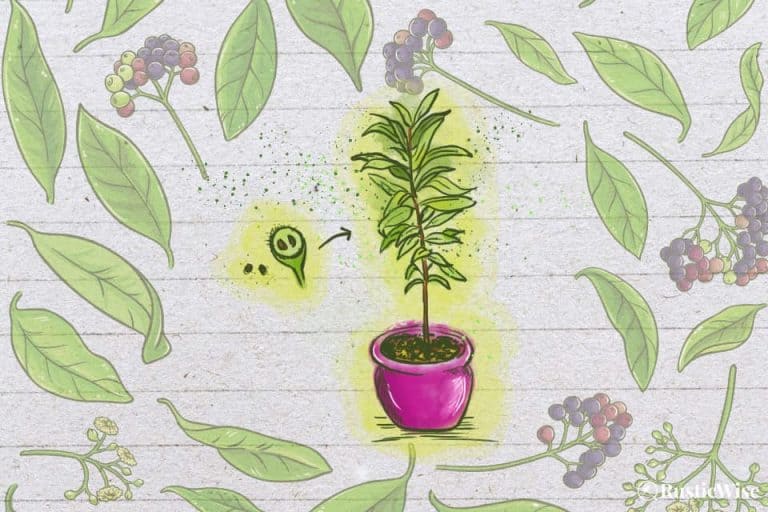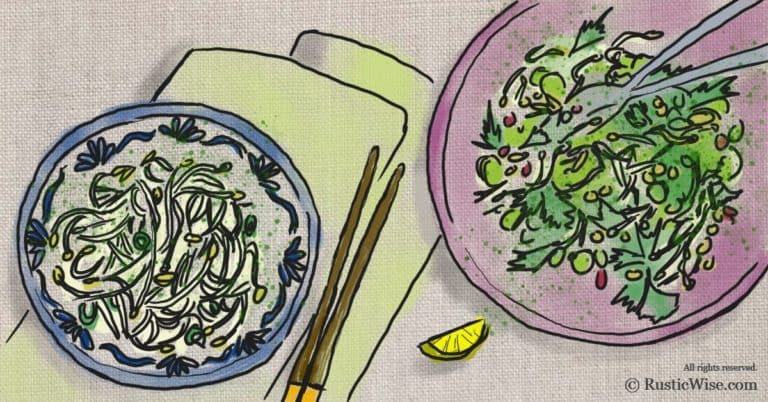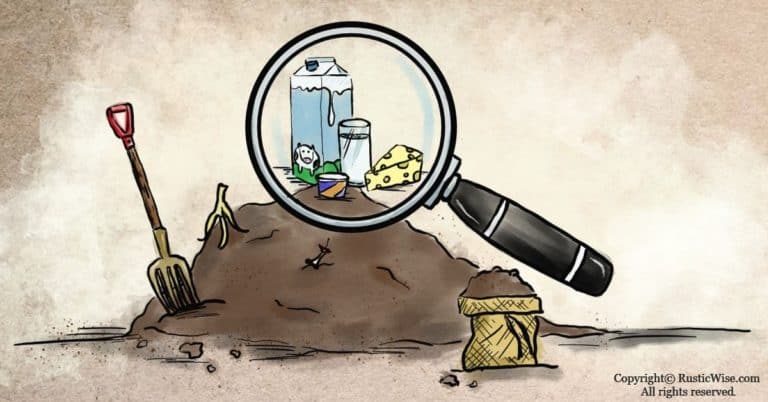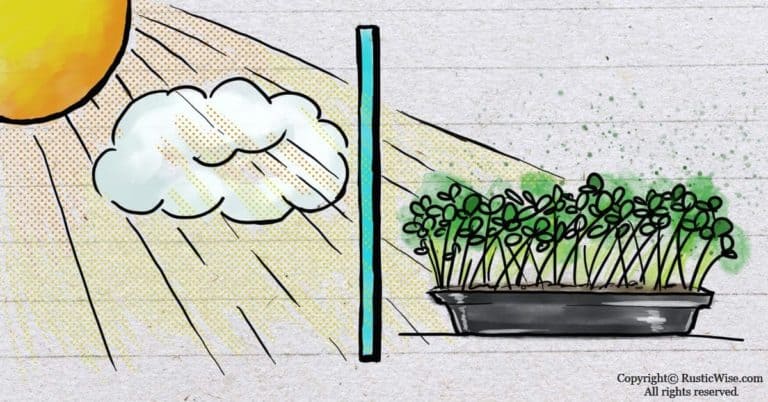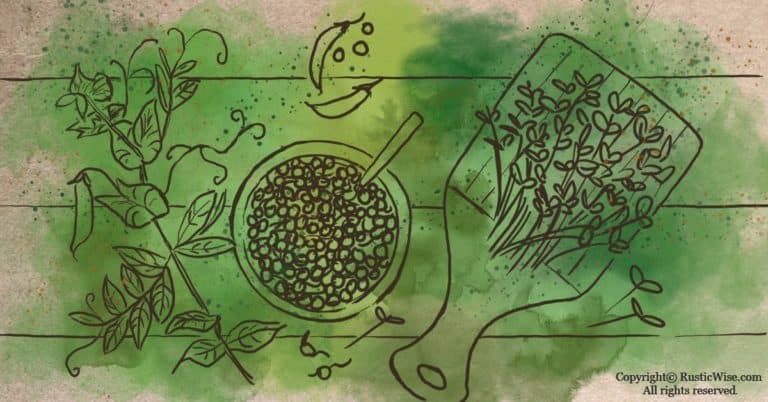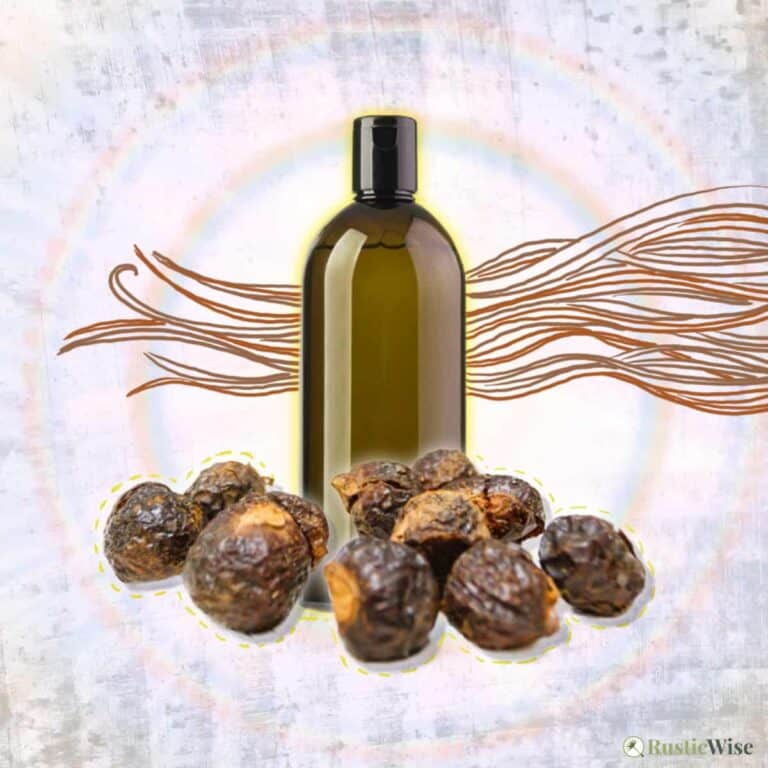An Intro To Growing Microgreens in Coconut Coir
RusticWise is supported by its readers. When you purchase through links on our site, we may earn an affiliate commission. As an Amazon Associate, we earn from qualifying purchases. Thank You!
If you’re looking for soilless growing mediums, coconut coir tops the list for many microgreens growers. It’s light, well-draining, and is great for retaining moisture (which means less need for watering!).
Also known as coconut peat or pith, there are a few tricks you’ll need to know about growing microgreens in coconut coir. Coco coir provides a cozy spot for root systems to develop into healthy greens. But it lacks the nutrients of regular potting soil (which may or may not be an issue depending on the type of micro you’re growing.)
Let’s take a look at the various types of coconut coir, the advantages and disadvantages of this growing medium, and what to look for in a good coir. Plus, we have a few tips on how to use this natural fiber to grow your own microgreen garden.
What is coconut coir, exactly?
Simply put, coconut coir for microgreens is a growing media that’s made from the husks of coconuts. More specifically, coir is the fibrous material found between the shell (the inner component), and the outer coat. It’s also called coconut peat, coconut pith or dust.
The finished product looks and feels an awful lot like regular soil. The difference is that this is a soilless or hydroponic grow medium.
Once upon a time, coconut husks were discarded as a waste byproduct of coconut processing. That is until people discovered the wonderful uses of this fibrous material as a soil amendment, or peat moss alternative.
With the popularity of hydroponic products, many people are interested in reusing the coco coir that is produced during the production of coconut oil and other products. The coir is essentially coconut fiber, making it a great material for keeping a healthy environment for plants.
The main types of coconut fibers
Coir refers to the fibers harvested from the the seed or fruit of the coconut palm tree (Cocos nucifera).
Coconut husks are harvested from the plant and then separated into long fibers and coconut pith. The pith is used to make coco peat or coir. It then goes through a processing method that involves shredding, washing, screening, and sorting. It’s a fibrous material that can be used in a variety of ways and comes in different forms:
- Coco peat or coir: This is finely shredded coir or pith that’s used as a mulch, fertilizer, or growing media for micros. It can come in premixed bags, or coir blocks (aka bricks, or briquettes if you want to get fancy). It’s also good for indoor and outdoor gardening purposes.
- Coconut grow mats: Coir also comes in mats which can be trimmed to fit your tray. This is used as a hydroponic media.
- Coconut fiber: A short and coarse natural fiber made from the outer shell of the fruit. It’s rich in lignins which makes it stronger and more durable than cotton. The fibrous strands are woven together to make geotextiles.¹
- Coconut chips or plugs: Made of small chunks of coconut husks, these are best suited for use as an organic mulch outdoors.
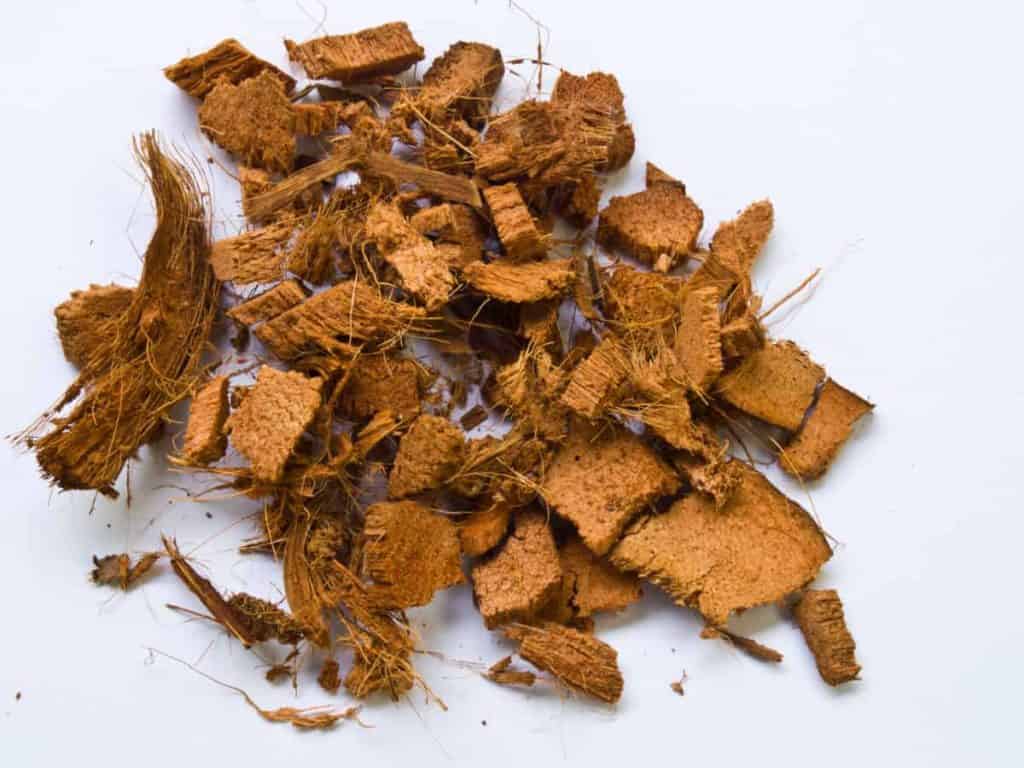
Credit: Yay Images
Why use coconut coir rather than soil?
In the world of microgreens growing, there are those who love using regular potting soil. Then there are those who are staunch supporters of soilless mixes using coco coir.
One of the main reasons growers choose to use soilless mixes is that soil can sometimes bring with it fungal or mold issues. It’s also more prone to pests.
Coco peat, on the other hand, is a sterile natural fiber that provides young greens with a light, yet supportive structure for root development.
There are many benefits to using coconut coir rather than soil for growing microgreens. One of the major benefits is that coir has a higher water holding capacity because of its unique fiber structure, which helps plants maintain a sufficient water supply.
Using coconut coir provides a more sustainable option over peat moss, and it can be used as a stand-alone medium as well.
A closer look at coco coir bricks vs. coir mixes
When planning your own indoor garden, coco peat comes in two main options: bricks or loose, ready-to-use mixes.
Coco coir bricks (aka blocks) are compressed coco pith. Most are roughly the size of small bricks and are made from 100 percent coco coir. They come in a variety of sizes.
Coir blocks provide the best bang-for-your-buck. Their compact size also saves you room when storing and is cheaper to ship (if you’re buying online). The downside is they need to be reconstituted with water (which requires a bit of work).
Loose, ready-to-use coco peat mixes are less work. But that convenience drives up the price.
Benefits of using coco coir for microgreens
Coir can be used as a highly effective, sustainable and inexpensive alternative to peat moss and inorganic growing mediums.
- Awesome water retention: The water retention capabilities of coco coir are many times its weight in water. Micros need consistent moisture and this natural fiber provides just that. You may find you need to do less watering when using coco peat.
- Light with good drainage: The light and airy qualities of this fiber provides excellent drainage and root aeration. Your micros are less prone to root rot or dampening off when using this medium.
- Neutral pH: Coconut fibers provide a nice Goldilocks pH level: not too acidic, and not too alkaline, but just right. Most coco peat has a slightly acidic pH.
- Sterile: You won’t need to worry about sterilizing a new pack of coco coir as it’s a naturally sanitary medium that’s not conducive to microbial growth, or harmful pathogens.
- Organic and renewable: Unlike peat moss which devastates local wetlands, coconut coir is harvested from quick growing coco palm trees and are made from the natural waste byproducts of the manufacturing process. According to Oregon State University, coco pith performs on par with peat moss for horticultural purposes.² And, unlike peat which develops at a glacial pace, a coconut harvest is done once every 45 days according to the Food and Agriculture Organization of the United Nations.¹
- Biodegradable: Unlike some inorganic growing substrates like rockwool, coco peat is completely biodegradable. Simply throw it into a compost pile when used.
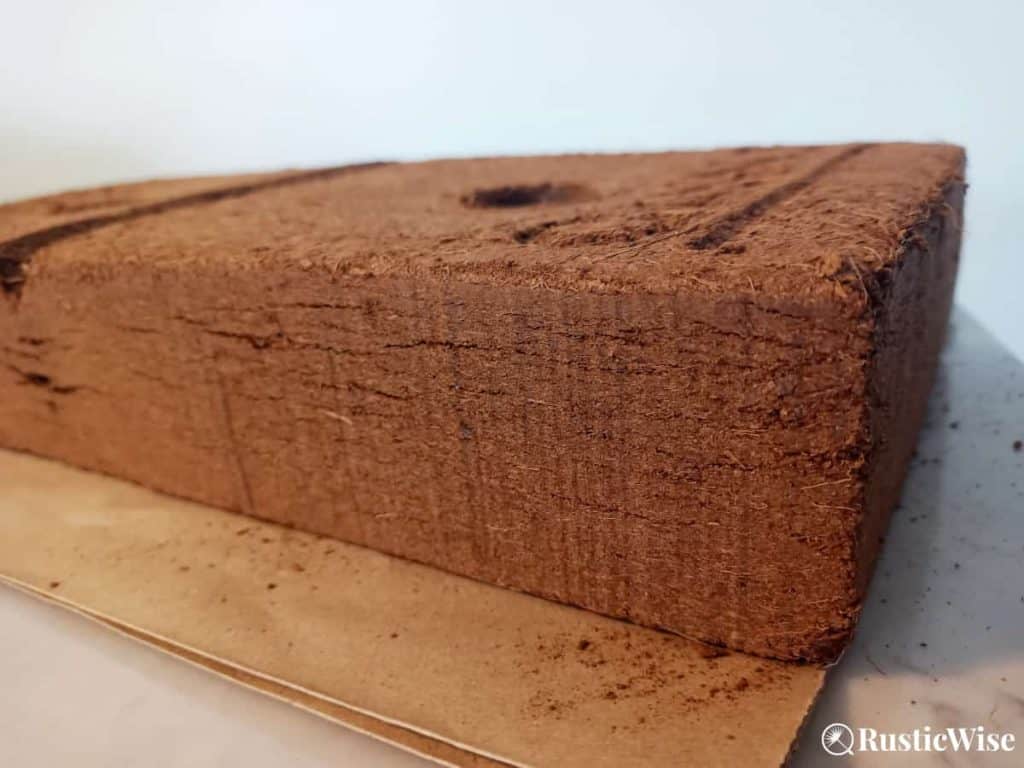
Credit: RusticWise
Downsides of using coco coir for microgreens
While coco coir is an outstanding growing medium that can work well in hydroponic and soil-based systems, let’s look at a few disadvantages.
- Lack of nutrients: One of the main drawbacks of coco peat is that it contains little to no nutrients needed to support healthy growth. While not exactly inert, it contains trace amounts of potassium and phosphorous. With the right nutrients combined with the medium, you should be able to achieve excellent growth.
- Can be messy: If you’re using coconut bricks, things can get a bit messy. You’ll need to rehydrate the substrate which involves mixing with water in a large bucket. You get the picture.
- May contain high levels of salt: Depending on the manufacturing process, some types of coco coir may contain high amounts of salt. After the fibers are extracted, they traditionally are left to cure in water or brine for several months. Some peat is rinsed with salt water (which leads to higher salt levels), while others are rinse with fresh water. Look for products with the label “low EC (electroconductivity)” or “low salt.”³
Tips for growing microgreens in coconut coir
There’s no right or wrong way to use coconut coir. Some methods may work better for some types of microgreens and not work well with others.
Some people swear by using this natural fiber as a standalone media. If you’re going this route, I would suggest adding nutrients via a liquid fertilizer for better growth. Or, try mixing it with compost or potting soil for added nutrients.
- Use alone with added fertilizer: Since coconut coir contains little nutrients with the exception of a bit of potassium and phosphorous, it will likely need a boost of some sort. Try a liquid kelp fertilizer or earthworm castings. This is especially important if you’re growing larger micros like sunflower microgreens, or pea shoots which can regrow.
- Use as part of a potting soil mix: You can reap the benefits of both nutrient-rich soil and coconut pith by combining the two mediums. Try making your own DIY soil mix with 1 part coconut coir to 2 parts potting soil. You can also add in a bit of compost if you have some that’s fully matured.
- Mix only what you need: If you’re getting big blocks of coco coir, try to break off only what you need. Hydrated coconut coir can still last several months if stored in plastic bags. Try to let the moisture dry out first and don’t seal the bag completely to allow for some airflow.
- Use warm water: Warm water works better than cold water to fluff up the medium. Hot water may damage the growing substrate.
- Get a BIG bucket: Coconut coil expands like crazy when hydrated. If you have a 5-gallon pail, or something similar, it will prevent you from making a mess.
How to cut a large coconut coir block
If you’re not using your whole brick of coco peat at once, it’s best to break off smaller chunks.
If you have a brick-size block, try to break it in half by pressing it against the edge of a table. Once it’s broken in half, you can use your hands to crumble the block into more manageable chunks.
If you have an extra large or thick block, try to cut off pieces in 2-inch wide strips (lengthwise) using a hacksaw, or something similar. The blocks seem to come apart easier lengthwise rather than widthwise.
Is coconut coir reusable for microgreens?
While coconut coir is structurally fine after one grow cycle of microgreens, I generally wouldn’t recommend reusing it again. This is because it’s very difficult to remove all the roots. The leftover roots may rot and cause root issues in your next batch. It’s better to start from scratch again for best results.
So, add it to your backyard compost. Or, mix it with potting soil and use it for other outdoor gardening projects.
How long does coconut coir last?
Coco pith is a remarkably durable soil amendment that can last up to 4 years. If you’re using it for garden beds, you can reuse it multiple times. (But as mentioned earlier, I don’t recommend reusing it for micros.)
How long does hydrated coco coir last? It depends on how you stored it, but it should be good for 4 to 6 months.
👉 If you like this post, see our Complete Guide to Growing Microgreens at Home. 🌱
Would you like more timeless tips via email?
Fun tips to help you live an independent, self-sustaining lifestyle. Opt-out at any time.


References
- Food and Agriculture Organization of the United Nations, Coir, https://www.fao.org/economic/futurefibres/fibres/coir/en/. Accessed November 2022.
- Oregon State University, Coir is sustainable alternative to peat moss in the garden, https://extension.oregonstate.edu/news/coir-sustainable-alternative-peat-moss-garden. Accessed November 2022.
- Johnny’s Seeds, Hydroponic Grow Media, https://www.johnnyseeds.com/growers-library/methods-tools-supplies/hydroponics/hydroponic-grow-media-common-types.html#c1. Accessed November 2022.

Author: Josh Tesolin
Josh is co-founder of RusticWise. When he’s not tinkering in the garden, or fixing something around the house, you can find him working on a vast array of random side projects.

